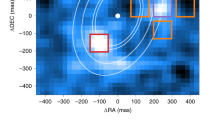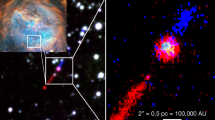Abstract
In their earliest stages, protostars accrete mass from their surrounding envelopes through circumstellar disks. Until now, the smallest observed protostar-to-envelope mass ratio was about 2.1 (ref. 1). The protostar L1527 IRS is thought to be in the earliest stages of star formation2. Its envelope contains about one solar mass of material within a radius of about 0.05 parsecs (refs 3, 4), and earlier observations suggested the presence of an edge-on disk5. Here we report observations of dust continuum emission and 13CO (rotational quantum number J = 2 → 1) line emission from the disk around L1527 IRS, from which we determine a protostellar mass of 0.19 ± 0.04 solar masses and a protostar-to-envelope mass ratio of about 0.2. We conclude that most of the luminosity is generated through the accretion process, with an accretion rate of about 6.6 × 10−7 solar masses per year. If it has been accreting at that rate through much of its life, its age is approximately 300,000 years, although theory suggests larger accretion rates earlier6, so it may be younger. The presence of a rotationally supported disk is confirmed, and significantly more mass may be added to its planet-forming region as well as to the protostar itself in the future.
This is a preview of subscription content, access via your institution
Access options
Subscribe to this journal
Receive 51 print issues and online access
$199.00 per year
only $3.90 per issue
Buy this article
- Purchase on Springer Link
- Instant access to full article PDF
Prices may be subject to local taxes which are calculated during checkout




Similar content being viewed by others
References
Takakuwa, S. et al. A Keplerian circumbinary disk around the protostellar system L1551 NE. Astrophys. J. 754, 52 (2012)
Andre, P., Ward-Thompson, D. & Barsony, M. Submillimeter continuum observations of Rho Ophiuchi A — the candidate protostar VLA 1623 and prestellar clumps. Astrophys. J. 406, 122–141 (1993)
Chandler, C. J. & Richer, J. S. The structure of protostellar envelopes derived from submillimeter continuum images. Astrophys. J. 530, 851–866 (2000)
Tobin, J. J. et al. Complex structure in class 0 protostellar envelopes. II. Kinematic structure from single-dish and interferometric molecular line mapping. Astrophys. J. 740, 45 (2011)
Tobin, J. J., Hartmann, L. & Loinard, L. The inner envelope and disk of L1527 revealed: Gemini L’-band-scattered light imaging. Astrophys. J. 722, L12–L17 (2010)
Foster, P. N. & Chevalier, R. A. Gravitational collapse of an isothermal sphere. Astrophys. J. 416, 303–311 (1993)
Jørgensen, J. K. et al. PROSAC: a submillimeter array survey of low-mass protostars. I. Overview of program: envelopes, disks, outflows, and hot cores. Astrophys. J. 659, 479–498 (2007)
Maury, A. J. et al. Toward understanding the formation of multiple systems. A pilot IRAM-PdBI survey of Class 0 objects. Astron. Astrophys. 512, A40 (2010)
Andrews, S. M. & Williams, J. P. Circumstellar dust disks in Taurus-Auriga: the submillimeter perspective. Astrophys. J. 631, 1134–1160 (2005)
Arce, H. G. & Sargent, A. I. The evolution of outflow-envelope interactions in low-mass protostars. Astrophys. J. 646, 1070–1085 (2006)
Ohashi, N., Hayashi, M., Ho, P. T. P. & Momose, M. Interferometric imaging of IRAS 04368+2557 in the L1527 molecular cloud core: a dynamically infalling envelope with rotation. Astrophys. J. 475, 211–223 (1997)
Dapp, W. B. & Basu, S. Averting the magnetic braking catastrophe on small scales: disk formation due to Ohmic dissipation. Astron. Astrophys. 521, L56 (2010)
Hennebelle, P. & Fromang, S. Magnetic processes in a collapsing dense core. I. Accretion and ejection. Astron. Astrophys. 477, 9–24 (2008)
Yorke, H. W. & Bodenheimer, P. The formation of protostellar disks. III. The influence of gravitationally induced angular momentum transport on disk structure and appearance. Astrophys. J. 525, 330–342 (1999)
Vorobyov, E. I. Embedded protostellar disks around (sub-)solar protostars. I. Disk structure and evolution. Astrophys. J. 723, 1294–1307 (2010)
Joos, M., Hennebelle, P. & Ciardi, A. Protostellar disk formation and transport of angular momentum during magnetized core collapse. Astron. Astrophys. 543, A128 (2012)
Simon, M., Dutrey, A. & Guilloteau, S. Dynamical masses of T Tauri stars and calibration of pre-main-sequence evolution. Astrophys. J. 545, 1034–1043 (2000)
Jørgensen, J. K. et al. PROSAC: a submillimeter array survey of low-mass protostars. II. The mass evolution of envelopes, disks, and stars from the Class 0 through I stages. Astron. Astrophys. 507, 861–879 (2009)
Tobin, J. J., Hartmann, L., Calvet, N. & D’Alessio, P. Constraining the envelope structure of L1527 IRS: infrared scattered light modeling. Astrophys. J. 679, 1364–1384 (2008)
Rodríguez, L. F. et al. Very Large Array observations of proper motions in L1551 IRS 5. Astrophys. J. 583, 330–333 (2003)
Hartmann, L., Cassen, P. & Kenyon, S. J. Disk accretion and the stellar birthline. Astrophys. J. 475, 770–785 (1997)
Evans, N. J. et al. The Spitzer c2d legacy results: star-formation rates and efficiencies; evolution and lifetimes. Astrophys. J. 181 (Supp.). 321–350 (2009)
Dunham, M. M., Evans, N. J., Terebey, S., Dullemond, C. P. & Young, C. H. Evolutionary signatures in the formation of low-mass protostars. II. Toward reconciling models and observations. Astrophys. J. 710, 470–502 (2010)
Narayanan, G., Snell, R. & Bemis, A. Molecular outflows identified in the FCRAO CO survey of the Taurus molecular cloud. Mon. Not. R. Astron. Soc. 425, 2641 (2012)
Bell, K. R., Cassen, P. M., Wasson, J. T. & Woolum, D. S. in Protostars and Planets IV (eds Mannings, V., Boss, A. P. & Russell, S. S. ) 897–926 (Univ. Arizona Press, 2000)
Andrews, S. M., Wilner, D. J., Hughes, A. M., Qi, C. & Dullemond, C. P. Protoplanetary disk structures in Ophiuchus. II. Extension to fainter sources. Astrophys. J. 723, 1241–1254 (2010)
Tobin, J. J., Hartmann, L., Looney, L. W. & Chiang, H. Complex structure in class 0 protostellar envelopes. Astrophys. J. 712, 1010–1028 (2010)
Acknowledgements
We thank E. Bergin for comments on the manuscript and W. Kwon for discussing improvements to the data reduction. J.J.T. was supported by NASA through Hubble Fellowship grant HSTHF-51300.01-A awarded by the Space Telescope Science Institute, which is operated by the Association of Universities for Research in Astronomy, Inc., for NASA, under contract NAS 5-26555. L.H. and J.J.T. acknowledge partial support from the University of Michigan. H.-F.C. was supported by NASA through the NASA Astrobiology Institute under cooperative agreement NNA09DA77A issued through the Office of Space Science. L.W.L. and H.-F.C. acknowledge support from the Laboratory for Astronomical Imaging at the University of Illinois and the NSF under grant AST-07-09206. P.D. acknowledges a grant from PAPIIT-UNAM. L.L. was supported by DGAPA, UNAM, CONACyT (México) and the Alexander von Humboldt Stiftung. Support for CARMA construction was derived from the states of Illinois, California and Maryland, the James S. McDonnell Foundation, the Gordon and Betty Moore Foundation, the Kenneth T. and Eileen L. Norris Foundation, the University of Chicago, the Associates of the California Institute of Technology, and the NSF. Continuing CARMA development and operations are supported by the NSF under a cooperative agreement, and by the CARMA partner universities. The Submillimeter Array is a joint project between the Smithsonian Astrophysical Observatory and the Academia Sinica Institute of Astronomy and Astrophysics and is funded by the Smithsonian Institution and the Academia Sinica. The National Radio Astronomy Observatory is a facility of the NSF operated under cooperative agreement by Associated Universities, Inc.
Author information
Authors and Affiliations
Contributions
J.J.T., H.-F.C., D.J.W. and L.W.L. participated in data acquisition and reduction. All authors contributed to the data analysis, discussed the results and commented on the manuscript.
Corresponding author
Ethics declarations
Competing interests
The authors declare no competing financial interests.
Supplementary information
Supplementary Information
This file contains Supplementary Text and Data 1-4, Supplementary Figures 1-3. Supplementary Tables 1-2 and additional references. (PDF 491 kb)
Rights and permissions
About this article
Cite this article
Tobin, J., Hartmann, L., Chiang, HF. et al. A ∼0.2-solar-mass protostar with a Keplerian disk in the very young L1527 IRS system. Nature 492, 83–85 (2012). https://doi.org/10.1038/nature11610
Received:
Accepted:
Published:
Issue Date:
DOI: https://doi.org/10.1038/nature11610
This article is cited by
-
Formation and Evolution of Disks Around Young Stellar Objects
Space Science Reviews (2020)
-
A warped disk around an infant protostar
Nature (2019)
-
Formation of wide binaries by turbulent fragmentation
Nature Astronomy (2017)
-
A triple protostar system formed via fragmentation of a gravitationally unstable disk
Nature (2016)
-
The Gas Disk: Evolution and Chemistry
Space Science Reviews (2016)
Comments
By submitting a comment you agree to abide by our Terms and Community Guidelines. If you find something abusive or that does not comply with our terms or guidelines please flag it as inappropriate.



